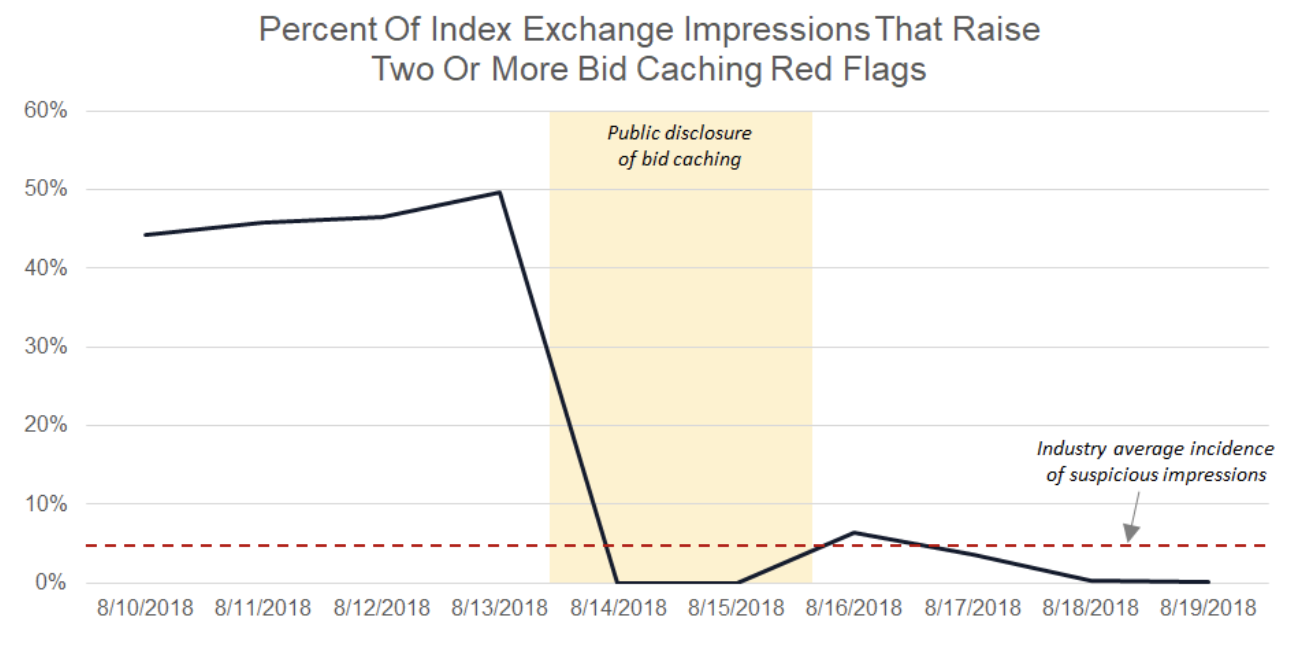Index Exchange recently confirmed they engaged in a practice called bid caching that many in the industry consider to be manipulative to buyers. They also recently confirmed they are discontinuing this practice. Our research indicates this practice was unique to Index and may have accounted for up to 50% of their filled impressions on some websites.
What Is Bid Caching?
There are two terms that are easily conflated but critically different: ad caching and bid caching.
Ad caching is an IAB-endorsed practice in which an auction is conducted in advance of an ad opportunity in order to reduce ad serving latency and improve the user experience. As an example, a mobile game might conduct an auction during gameplay in order to fill an interstitial ad that renders between game levels. Ad caching is especially useful in environments with poor internet connection speeds and unreliable connection quality.
Bid caching is the practice of utilizing a lost bid from one auction to fill a subsequent auction for the same user on the same piece of content. For example, an advertiser’s bid for a homepage ad impression might be used to fill an impression on an article page later in that user’s session. In cases where an auction captures either low bids or no bids from DSPs, bid caching enables the exchange to deliver elevated clearing prices to their publisher partners. The yield benefits of bid caching are particularly useful to exchanges in header bidding environments where multiple exchanges compete to produce the highest price for each available impression.
Ad caching conducts an auction in advance of the impression’s availability with the goal of improving the user experience. Bid caching transfers bids from one auction to another with the goal of boosting publisher yield.
How Common Is Bid Caching?
In early August 2018, we conducted a series of bidding tests through a major DSP with the goal of identifying the incidence of bid caching. Our tests delivered over 1.7 million impressions across a mix of comScore 1,000 websites that each sell their inventory through multiple header-enabled RTB ad exchanges. We served a single 300x250 banner ad to a US-based audience.
Bid caching is most easily detectable for impressions that violate a campaign’s frequency cap. In these cases, an impression serves for an auction in which the DSP should not have participated. Some frequency cap violations are unavoidable and do not necessarily indicate bid caching, but other frequency cap violations carry the hallmarks of a cached bid. To maximize the number of observed frequency cap violations, we configured our test campaign with a 1-per-lifetime user frequency cap. We then audited all cases in which a user was served more than one impression to determine if the frequency cap violation was caused by unavoidable factors or by bid caching.
Bid caching red flags
Using bidding logs and ad serving logs from our test campaign, we audited all 1.7 million impressions to detect cached bids. While it is not possible to know the inner workings of each ad exchange, we monitored for three red flags that we believe suggest the presence of bid caching:
Bid Request Page Mismatch: When an impression violates a frequency cap, is it served on a URL that is different from the URL declared in the bid request?
Sequential Page: When an impression violates a frequency cap, is it served on a URL that is different from the URL where we delivered this user's prior impression?
Time Lag: When an impression violates a frequency cap, is it served more than 10 seconds after the user's prior impression?
The presence of any one of these red flags does not necessarily indicate bid caching and might be explained by a variety of nuanced factors relating to DSP frequency cap enforcement latency, ad exchange win notification delays, and publisher data leakage protections. But when we observe an impression with two or three red flags, we have increasing confidence that the exchange is engaging in bid caching.
Bid caching examples
Based on the three bid caching red flags, we identified and manually inspected suspicious impressions. For each suspicious impression, we also inspected the user’s prior ad exposure. Here is an example of an impression that we believe is the result of a cached bid on a major US publication:
This impression raises all three of our bid caching red flags:
Bid Request Page Mismatch: The bid request declares the ad will be served on the publication’s homepage, but the impression is actually delivered on an article page.
Sequential Page: The article page on which this impression serves is different from the article page on which we previously reached this user. Assuming our frequency settings are enforced by the DSP, it would not participate in auctions for this second page view.
Time Lag: The impression is served 71 seconds after we received a win notification for the user’s prior impression. The DSP’s frequency enforcement mechanism has had sufficient time to process the prior win notification and should no longer be bidding into auctions for this user.
Sizing bid caching’s impact
Our test campaign delivered over 1.7 million impressions across the following nine ad exchanges:
AppNexus
BidSwitch
Index Exchange
Google Ad Manager
Oath
OpenX
PubMatic
Rubicon Project
Sovrn
Eight of these nine exchanges consistently exhibited no signs of bid caching. For every exchange, we monitored the percentage of daily impressions that raised two or more red flags. We believe this methodology is subject to at most a 5% incidence of false positives, and every exchange other than Index consistently maintained suspicious impression volume below this 5% threshold.
Prior to August 14th, 44-50% of the daily impressions we purchased on Index Exchange raised two or more bid caching red flags. Between August 14th and August 16th, AdExchanger published a story about bid caching(1), Index confirmed they engage in the practice(2), and many buyers began to challenge the integrity of Index’s auction. Also during this period, we observed the incidence of bid caching red flags on Index Exchange drop to industry norms. On August 19th, Index publicly confirmed they were discontinuing the use of bid caching(3).
The speed of this drop in suspicious activity provides confirmation that Index quickly responded to buyer pushback and discontinued the practice of bid caching. The magnitude of the drop also suggests to us that cached bids may have accounted for as many as 50% of the impressions filled on Index Exchange prior to August 14th.
Shining A Light
Our industry is healthier today than it was a week ago. AdExchanger’s article created an important industry discussion that brings more clarity to all market participants. Index appears to have listened to buyers and eliminated what many view as an unfair auction mechanism. When our industry shines a light on bad practices, the marketplace becomes a more trusted environment, and that’s good for both buyers and sellers.
About This Research
Jounce Media is an tech consultancy that partners with marketers, publishers, and ad tech intermediaries. Our clients include multiple of the ad exchanges named in this report, but those clients have neither funded nor directed this research. All test campaigns were managed and funded by Jounce Media, and all findings in this report represent our independent perspective on bid caching.
1: http://www.indexexchange.com/commitment-user-experience/
2: https://adexchanger.com/platforms/index-exchange-called-out-for-tweaking-its-auction/
3: http://www.adnews.com.au/news/index-exchange-ceo-disappointed-in-own-level-of-transparency


